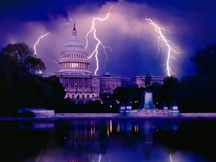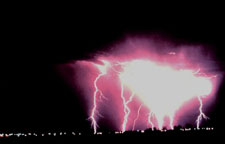 |
 |
 |
 |
 |
||
Types of Lightning |
|||||
After you read about the different types of lighning on this page, try the Lightning Quiz to see how much you learned. Cloud-to-Ground Often, cloud-to-ground lightning bolts strike the highest object, like the top of a building or the top of a tall tree. The lightning strikes can cause fire and property damage. If a person is the highest object in the lightning bolt's path, the lightning may strike the person. Lightning strikes can cause severe injury or death. Cloud-to-ground lightning is the best understood type of lightning because it leaves so much evidence behind. IntraCloud InterCloud Forms of Lightning When lightning appears it can take many different forms and look very different. Some of these forms are described below. Forked
lightning
appears as jagged or crooked lines of light. They can have several
branches. Forked lightning can be seen shooting from the clouds to
the ground, from one cloud to another cloud, or from a cloud out into
the air. This lightning can strike up to 10 miles away from a thunderstorm
and appear to be coming out of a clear blue sky. The phrase, "out
of nowhere" or "out of the clear blue" might well describe
some of these forked lightning strokes. Sheet lightning appears as flashes of light that seems to light up or illuminate entire clouds. This makes the clouds visible far away. Heat lightning is the term used to describe lightning flashes that are too far away from you to hear the thunder. Heat lightning is created by thunderstorms that are usually more than 10 miles away. The reason it is called heat lightning is that it appears most often in the hot summer when the sky overhead is clear. Ball lightning is very rare. (In fact some scientists say it does not exist at all.) Reports of ball lightning have been made by passengers on planes and ships as well as from people that experienced it in their homes. These form of lightning appears as a glowing ball less than three feet wide. It lasts from a few seconds to several minutes and then disappears. Usually there is no damage from ball lightning except for burn marks left where it traveled through screens or windows. St. Elmo's Fire appears as a blue or greenish glow above pointed objects on the ground. It was named for the patron saint of sailors. It is created when tiny positively charged sparks reach up in response to negative charges in the air or clouds above the ground. Instead of a lightning strike the glow appears from objects such as a ship's mast, a power pole, tall antennae, or the wings of an aircraft. If a thunderstorm is nearby, St. Elmo's Fire might be seen right before a lightning strike. High-altitude lightning has been given other names such as "red sprites," "green elves," and "blue jets." This form of lightning appears as brightly colored flashes, high above thunderstorms. These flashes shoot up above the thunderstorm about the same time as other lightning discharges inside the storm cloud. More about High-altitude lightning can be found at the Red Sprites and Blue Jets page or at the New Mexico Tech's Sprite Page.
|
|
||||
|
|
|||||
|
|||||
|
|||||
|
|||||






